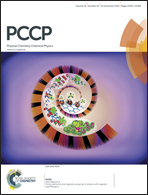Realizing semiconductor–half-metal transition in zigzag graphene nanoribbons supported on hybrid fluorographene–graphane nanoribbons†
Abstract
Hydrogenation and fluorination provide promising applications for tuning the properties of graphene-based nanomaterials. Using first-principles calculations, we investigate the electronic and magnetic properties of zigzag graphene nanoribbons (ZGNRs) supported on hydrogenated and fluorinated ZGNRs. Our results indicate that the support of zigzag graphane nanoribbon with its full width has less impact on the electronic and magnetic properties of ZGNRs, whereas the ZGNRs supported on fluorographene nanoribbons can be tuned to metal with almost degenerated ferro- and anti-ferromagnetic states due to the intrinsic polarization of substrate. The ZGNRs supported on zigzag hybrid fluorographene–graphane nanoribbons are spin-polarized half-semiconductors with distinct band gaps for spin-up and spin-down channels. Interestingly, in the absence of an external electric field, the spin-polarized band gaps of supported ZGNRs can be well modulated in the opposite direction by changing the ratio of fluorination to hydrogenation concentration in hybrid substrates. Furthermore, the ZGNRs supported on hybrid nanoribbons exhibit the half-semiconducting to half-metallic behavior transition as the interlayer spacing is gradually reduced, which is realized more easily for the hybrid support with a relatively wide fluorographene moiety compared to its narrow counterpart. Present results provide a novel way for designing substrate-supported graphene spintronic devices.


 Please wait while we load your content...
Please wait while we load your content...